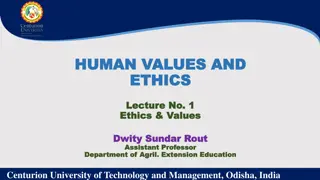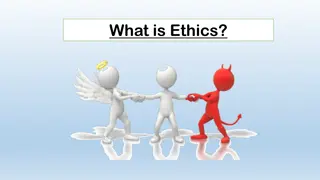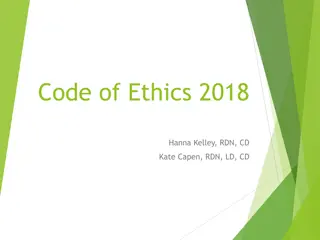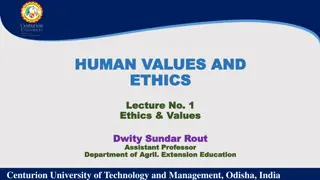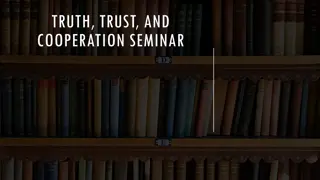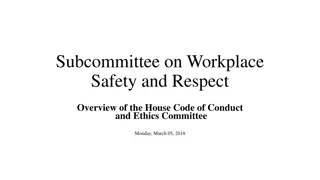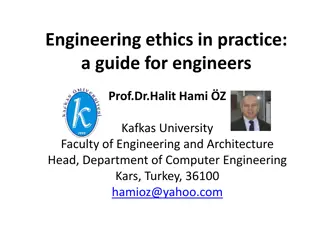Computer Ethics and Sociotechnical Issues
Dive into the realm of computer ethics and society through scenarios like virtual rape in LambdaMOO, privacy concerns on Facebook, and ethical implications of RFID technology. Discover the evolving ethical landscape shaped by information technology, raising questions beyond traditional moral theories.
Download Presentation

Please find below an Image/Link to download the presentation.
The content on the website is provided AS IS for your information and personal use only. It may not be sold, licensed, or shared on other websites without obtaining consent from the author.If you encounter any issues during the download, it is possible that the publisher has removed the file from their server.
You are allowed to download the files provided on this website for personal or commercial use, subject to the condition that they are used lawfully. All files are the property of their respective owners.
The content on the website is provided AS IS for your information and personal use only. It may not be sold, licensed, or shared on other websites without obtaining consent from the author.
E N D
Presentation Transcript
Computer Ethics and Society 1
Chapter 1: Introduction to sociotechnical computer ethics 2
Scenarios Scenario 1.1. A virtual rape The incident occurs on a multiuser designed object-oriented program LambdaMOO that allows users to create characters on it to interact with each other After being controlled through its subprogram by another program(Bungle), the later represents a scene of raping of the virtual characters created Issues: Who is responsible? What are the consequences? 3
Scenario 1.2. Surprises about Social networking Feature of Facebook: Every time a user adds a friend to his/her list, all of the user s friends were alerted Beacon feature on Facebook: An automated notification of a Facebook s user s friends when he/she made an online purchase 4
Facebook is used by recruiters and law enforcement agencies in order to gather information concerning potential employees or evidence related to crimes, so obviously for nonsocial networking purposes Issues: Are Facebook, the recruiters or the law enforcement agencies responsible? 5
Scenario 1.3. Radio-Frequency identification Electronic- health new technology consisting in placing a small chip under a patient s skin Issue: What shall the legal guardian of the patient do? 6
Introduction: Why computer ethics? Connection between ethical issues and information technology: Does information technology create new ethical issues or new versions of old ethical issues with new dimensions? It was stated that existing common rules and principles are unable to govern ethical issues raised by the use of computer ethics 7
Meta-questions: Scholars have asked whether the traditional theories can be applied to these particular ethical issues or whether new moral theories are needed They were also wondering if there is an actual need for a special field of study for Information Technology (IT) ethics or if it is possible to apply the rules and principles of ethics in general 8
The emergence and generalization of the use of the internet have raised a similar question concerning the applicability of the existing laws and regulations to cyberspace Some internet actors expressed their wish to be excluded from those laws that they pretend being designed for offline world John Barlow has drafted in 1996 a declaration of independence of the internet He was trying to prove the reason for which the cyberspace shall be self regulated 9
Some others called the legislator to enact new special provisions especially designed to govern electronic transactions, electronic liabilities, electronic contracts, cyber crimes However, all these wishes were not realized because it quickly appeared that a large number of issues raised by the internet in many fields can be governed by existing laws after adaptation and interpretation of those laws Concerning certain particular issues, especial laws were enacted 10
The standard account New possibilities, a vacuum of policies, conceptual muddles James Moor s account 1985 Computers and information technology create new possibilities and opportunities for human action, individually and collectively, there is a vacuum of policies to regulate those new opportunities Thus, the task of computer ethics is to evaluate the new possibilities and to fill the vacuum by addressing conceptual muddles 11
An update to the standard account Apparition of many factors demonstrating the need to update the classical theory Experience of the computer ethicists in analyzing IT ethical issues Development of a new field Science and Technology Studies providing insights to understand how ethical notions are shaped by technology 12
So, It appeared that the standard account is applicable to all new technology ethics and not only to IT ethics 13
The standard account focuses on the newness of the IT However, one cannot consider that newness in IT is a stable element since what is new today is considered to be old tomorrow in the world of technology Thus, it is not appropriate to frame computer ethics as a field focused exclusively on the novelty of IT 14
The Sociotechnical Systems Perspective A brief insight on the emerging field of study STS : Science and technology studies or Science, technology and society Reject technological determinism/ Think coshaping Technological determinism contains 2 main claims: 15
1. Technology develops independently from society i.e. technological development is an independent activity with a natural evolution separated from social forces 2. When a technology is taken up and used in a society, it determines the character of that society 16
STS have commented on 2 claims 1. According to them, the first claim should be rejected since the character and direction of technological development are influenced by a wide range of social factors like political decisions, social incidents, legal environment that could facilitate or constrain innovation 17
2. As for the second claim stating that adoption of technologies determine patterns of social behaviors, STS scholars have given a finely shaded opinion 18
In fact, it is not correct to say outright that technology determines society because as we have already said, technology is shaped and designed by social considerations and factors It is more precise to state that technology shapes society Thus, technology and society shape each other, they cocreate one another It is a two ways direction movement 19
Reject technology as material object/ Think sociotechnical systems Presumption about technology: Connect technology to physical objects, artifacts, human- made material objects STS scholars: It is a false conception of technology because if material objects are necessary in technology, they don t have any significance unless they are embedded in social practices and activities 20
Technology is the invention of human activity and social forces Technology is socially constituted and it works as part of a social system 21
STS scholars consider that technology should be presented as a sociotechnical system Presenting technology as connected to society and practices proves the connection between ethics and IT Traditionally, ethics focused on human behavior exclusively and not on technology since it is considered to be neutral and purely scientific However, since human action and artifacts are intertwined in the process of technology, a bound appears clearly between technology and ethics 22
Reject technology as neutral/ Think technology infused with values General mistake: Technology is value neutral An important work elaborated in the matter by Langdon Winner- 1986 Do artifacts have politics ? Main idea: Existence of a connection or a relationship between technology and systems of power, authority, decision making 23
Example: Construction of a bridge in New York between the city and the beaches intentionally in a certain manner that constrains the access of public buses (especially of people using public buses) 24
Combination of material elements and social practices constitute a social arrangement Difference between this account and technological determinism : technology shapes, influences but does not determine social arrangements or behaviors 25
Sociotechnical Computer Ethics Sociotechnical computer ethics is constituted by the 3 STS lessons Facebook and the three STS lessons First lesson of STS: Reject technological determinism Facebook is a system designed in order to enhance patterns of interaction and increase relationships between users Facebook shapes friendships, but does not determine social relationships 26
Second lesson of STS: Reject technology as material object Conception of Facebook as a social networking site and not as a piece of software General conviction that Facebook is a platform involving a large number of stakeholders including: 27
Users: They post the content, photos, comments, communication messages Administrators or operators: They take the decisions concerning the internal organization of the platform 28
Third lesson of STS: Reject technology as neutral Facebook is a social networking site Facebook users want to maintain a certain range of privacy 29
Conflict between: Facebook users values: keeping some privacy Facebook s values: making money E.g: Beacon scenario 1.2. An automated notification of a Facebook user s friends when he/she makes an online purchase that increases advertising revenue for Facebook 30
What is the link between sociotechnical systems perspective and the analysis of IT ethical issues? How does sociotechnical systems perspective contribute in understanding ethical issues? Perspectives provide us with a complete picture of the situation involving moral questions 31
Radio Frequency identification: A sociotechnical system and not a material object because: It involves the work of developers during the process and taking into consideration interests of various stakeholders( hospitals, patients ) It will generate the emergence of a set of social practices Consequence on the hospital environment 32
Scenario 1.3. The legal guardian has to evaluate the whole situation by asking a set of questions related to risks and method of implantation, reception and use of data 33
Micro- and Macro- Level Analysis Micro-level analysis focuses on individuals, their choices, their decisions, their behaviors Macro-level analysis focuses on groups, organizations, countries, rules ,regulations, policies and systems Sociotechnical systems perspective is compatible with and useful to, both levels of analysis 34


